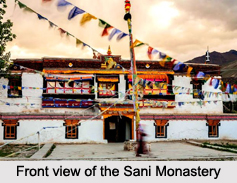 Sani Monastery is a part of Drukpa Kagyupa School. The principal attraction is Kanika Stupa, situated in the backyard of the monastery. The monastery is located next to the village of Sani. It is 6 km to the north west of the regional centre of Padum and it is thought to be the oldest religious site in the whole region of Ladakh and Zanskar. Sani monastery is also known as `Turtot Gyat` and it is considered to be one of the eight holy places of the Buddhist.
Sani Monastery is a part of Drukpa Kagyupa School. The principal attraction is Kanika Stupa, situated in the backyard of the monastery. The monastery is located next to the village of Sani. It is 6 km to the north west of the regional centre of Padum and it is thought to be the oldest religious site in the whole region of Ladakh and Zanskar. Sani monastery is also known as `Turtot Gyat` and it is considered to be one of the eight holy places of the Buddhist.
The Sani monastery is a significant place of pilgrimage of the Drukpa Kagyupa School of Tibetan Buddhism and belongs to its southern branch. One of the unique things about this monastery is that it has been constructed in different parts over a course of several centuries.
History of the Sani Monastery
The stupa dated back to the 2nd century. There is a huge central prayer hall that houses an assortment of statues of Buddhist saints. A chapel is also attached, where a fascinating collection of frescoes and stucco murals can be seen. Another highlight is an erstwhile cemetery, an excellent example of ancient rock carvings. Sani Monastery relates to a saint named Naropa, who is believed to have mediated here for sometime under the Kanika Stupa.
Architecture of the Sani Monastery
The Monastery resembles a huge castle. The architecture of the Sani Gompa has a prayer hall and 2nd century Kanika Stupa within its building. Statues of Buddhist deities and revered Lamas adorn the central hall with the elaborate wall painting designs and thangkas on its walls. Behind this monastery, there is a small chapel that has murals related to the life of Guru Padmasambhava and a holy cremation ground, enveloped with complicated rock carvings, is situated right outside the monastery complex.
The Sani Monastery is decorated with a lively collection of statues of Buddhist deities and Kargud-pa"s Lamas. There is a crematorium exterior side of the monastery complex which is considered to be one of the eight most important cremation grounds for Tibetan Buddhists. The crematorium has a ring of ancient rock paintings on its perimeter which has a touch of Indian art as well to it.
Attractions of the Sani Monastery
The main building consisting of a large multi-columned central prayer hall is also an attraction of Sani Monastery apart from the Kanika Stupa and the prayer hall which displays a number of different types of statues of popular Buddhists divinities and `Drugpa` saints along with the walls of the hall, constructed in the 17th century are adorned with frescoes and thankas attracting a number of tourists.
Other Attractions
Apart from the Sani Monastery, there are few other monasteries which can be visited in the Zanskar district such as the Stagrimo Monastery and the Karsha Monastery which happens to be the largest monastic complex of the Zanskar region. The highlight of the monastery is large valuable thankas and equally precious scrolls and idols. The Zongkhul Monastery is another monastery which is famous for its frescoes.
Festivals at Sani Monastery
The festival of Naro Nasjal is celebrated every year in the monastery in the month of July. It takes place during the blooming of the `Guru Naropa Flower`. This is the time when people from all over the Zanskar valley come over to the monastery to be a part of the two day long festival and enjoy a masked dance performance by the lamas of the Bardan Monastery. Sani is associated to a saint named Naropa, who is understood to have meditated here for sometime under the Kanika Stupa. A veiled bronze image of Naropa can be seen here. During this festival, the bronze statue of Naropa is unveiled for the common people to memorialize the occasion.
Another festival is an annual ritual reading of the Tibetan canon, the `Great Prayer Festival`, held at the monastery during winter with the firewood provided by villagers in the region. From time to time the monks boil up goats` heads in a long ceremony in which symbols of fortune and other garnishing is added according to the wealth of the person sponsoring this activity. These goats` heads hang outside the houses of almost every house in Leh and are thought to bring good fortune.
Connectivity of the Sani Monastery
Visitors can reach the Sani Monastery by air from the Srinagar and Leh airports. The Sani Monastery lies on the Kargil-Padum road which is around 6 km before Padum. B-class bus service run by the J&K SRTC is available thrice a week but the tourists in group can even go for A-Class or even Super-Deluxe buses, jeeps and gypsy taxis to reach the Sani Monastery.



















